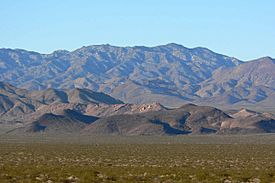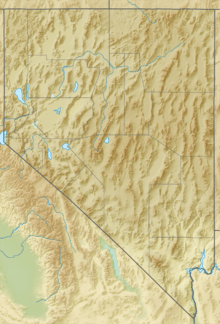McCullough Range facts for kids
Quick facts for kids McCullough Range |
|
|---|---|

The McCullough Range as seen from Eldorado Valley in Southern Nevada
|
|
| Highest point | |
| Peak | McCullough Mountain |
| Elevation | 2,141.5 m (7,026 ft) |
| Geography | |
| Country | United States |
| State | Nevada |
| District | Clark County |
| Range coordinates | 35°54′57″N 115°2′54″W / 35.91583°N 115.04833°W |
| Topo map | USGS Sloan NE |
The McCullough Range is a group of mountains mostly found near the city of Henderson in Nevada, United States. These mountains are special because they have two different parts. The northern part was formed by volcanoes, while the southern part is made mostly of metamorphic rock, which is rock that has changed due to heat and pressure.
The McCullough Range got its name from an early settler who lived in the area.
Contents
Protecting the McCullough Range
Parts of the McCullough Range are protected as special wilderness areas. The northern part is called the North McCullough Wilderness Area, and the southern part is known as the South McCullough Wilderness Area. These areas are managed by the U.S. Department of the Interior's Bureau of Land Management.
The North McCullough Wilderness Area is also part of the Sloan Canyon National Conservation Area, which helps protect it even more. These protections ensure that the natural beauty and wildlife of the mountains are kept safe for everyone.
Where is the McCullough Range?
The McCullough Range is surrounded by three large valleys. To the north is the famous Las Vegas Valley. To the west, you'll find the northern part of the Ivanpah Valley, which has two big dry lakes. To the east is the Eldorado Valley, which is a basin where water collects but doesn't flow out to the ocean.
At its southern end, the McCullough Range connects to the higher hills of the New York Mountains. Just a bit northeast of where these two ranges meet, and in the southwest of Eldorado Valley, is the smaller Highland Range.
Plants and Animals of the McCullough Range
The McCullough Range is home to a variety of plants and animals, thanks to its unique environment.
Northern McCullough Range: Volcanic Peaks
In the northern part of the McCullough Range, the land goes from about 2,000 feet high at the eastern base to 5,092 feet at Black Mountain. The peaks here were formed by volcanoes. They are often rounded or flat on top, with a steep slope on the east side and a gentler slope on the west.
This area has a special mix of plants from different desert regions, including the Mojave, Sonoran, and Great Basin Desert ecosystems.
The main plant you'll see is the creosote bush. You can also find barrel cactus, Joshua trees, different kinds of chollas, and prickly pear cacti. Unlike other mountains in Clark County, the McCullough Range shows clear signs of its volcanic past, like lava flows and ash.
You might also spot black gramma grass, which is rare in Nevada, and Teddy bear cholla, which is found here at its northernmost point. The area also has amazing petroglyph panels (ancient rock carvings) and other important cultural sites.
One peak northeast of Black Mountain is important for modern communication, as it holds most of the radio and television towers for the Las Vegas Valley.
Southern McCullough Range: Ancient Rocks
The southern part of the range runs north to south and gradually slopes down into many valleys and foothills on its east and west sides. Elevations here range from about 2,500 feet in the northwest to 7,026 feet at McCullough Mountain, which is in the center of this wilderness area.
Most of this southern area is made of very old Precambrian rock that has changed over time, along with granite and schist. However, you can also find basalt and andesite lava flows in the northern parts of this section.
Different plants grow at different elevations:
- Below 4,500 feet: Creosote bush scrub.
- Between 3,500 and 5,000 feet: Joshua trees, Mojave yucca, and other cacti.
- Between 4,500 and 5,000 feet: Blackbrush.
- Above 5,000 feet: Pinyon-juniper trees.
You can also find scattered mesquite and catclaw communities in the dry streambeds (washes) throughout the area.
Signs of ancient human life have been discovered here, including rock art, old living sites, and places where pinyon pine nuts were stored. This land was historically part of the homeland of the Mohave people.
The southern McCullough Range is also home to several animals, including the desert tortoise, Nelson bighorn sheep, Gambel's quail, and chukar.


